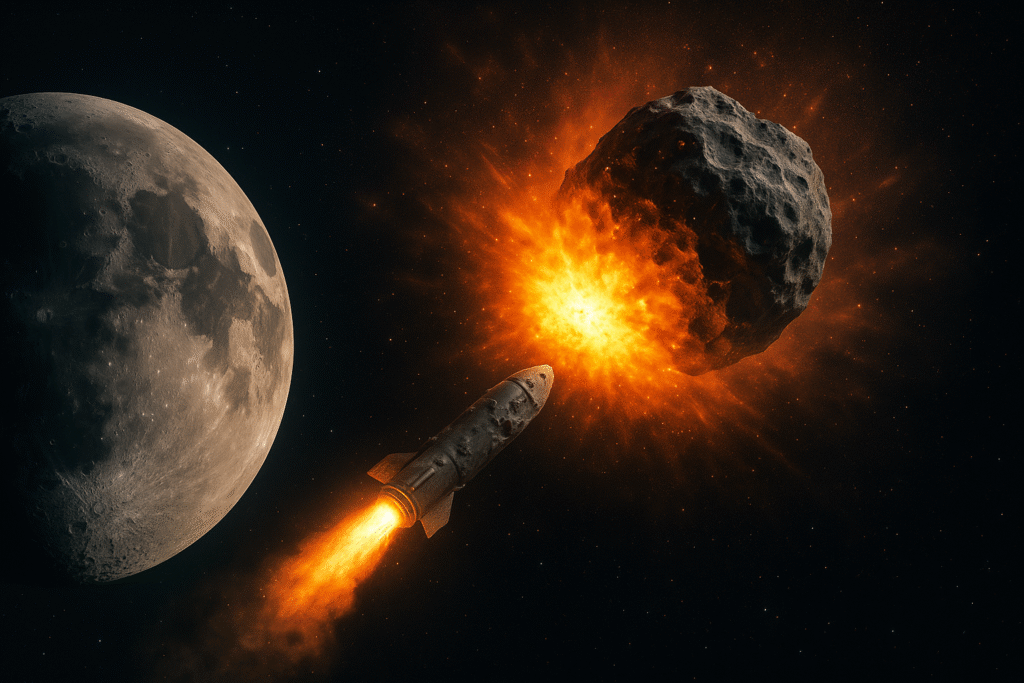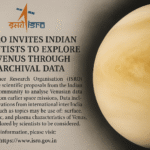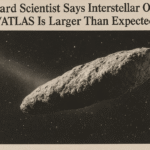By Harshit | 29 September 2025 | Washington, D.C., USA | 9:30 AM EDT
NASA is exploring the possibility of deploying nuclear weapons to prevent an asteroid from colliding with the Moon — a dramatic step that underscores the high stakes of planetary defense. The asteroid, designated 2024 YR4, was first spotted in December 2024 and initially sparked global concern when early calculations suggested a small but real chance of hitting Earth in 2032.
While follow-up observations have significantly reduced the likelihood of an Earth impact, scientists now warn that the asteroid could still strike the Moon, triggering consequences that extend beyond its cratered surface.
The Threat from 2024 YR4
Estimated to measure between 53 and 67 meters in diameter, 2024 YR4 is large enough to cause notable damage if it impacts a planetary body. Although its Earth impact probability has dropped to about 3 percent, its trajectory still intersects uncomfortably close to the Moon.
A lunar collision could unleash “lunar ejecta” — vast clouds of dust and rock debris blasted from the surface. Scientists caution that these fragments, propelled into space, could drift into low Earth orbit, creating hazards for satellites, spacecraft, and even astronauts operating in near-Earth space.
“Even tiny micrometeoroid particles can puncture spacecraft shielding or compromise astronaut suits,” said one researcher, noting that debris management would be as critical as the impact itself.
Options on the Table
NASA and its international partners are now assessing two main strategies:
- Deflection – Using a kinetic impactor, similar to NASA’s 2022 DART mission, to nudge the asteroid off course.
- Destruction – Employing nuclear explosives to fragment or vaporize the asteroid before it reaches the Moon.
Initially, scientists considered a DART-like deflection attempt, but the approach has been deemed impractical for 2024 YR4. The asteroid’s mass remains poorly constrained, making trajectory predictions uncertain and increasing the risk that a deflection attempt could fail or even worsen the threat.
Considering Nuclear Detonation
The bolder option under review involves the use of nuclear devices. According to preliminary studies, NASA is weighing the deployment of two 100-kiloton nuclear bombs — each up to eight times more powerful than those dropped on Hiroshima and Nagasaki during World War II.
One device would serve as the primary strike, while the second would act as a backup should the first fail. Scientists also note that a single 1-megaton detonation — well within the current U.S. nuclear arsenal — would likely be sufficient to obliterate 2024 YR4 entirely.
If adopted, such a mission would mark a historic first: the intentional use of a nuclear explosion in space to destroy an asteroid. The only precedent dates back to the 1960s, when the United States conducted high-altitude nuclear tests for military research, not planetary defense.
Risks and Uncertainties
Despite the appeal of a decisive solution, experts caution that nuclear intervention carries its own risks.
- The unpredictability of fragmentation – Blowing up the asteroid could scatter large pieces, some of which might still threaten Earth or orbiting satellites.
- Radiation effects – While minimal in the vacuum of space, the detonation could interfere with instruments and spacecraft operating nearby.
- International concerns – The militarization of space through nuclear weapons raises geopolitical and treaty-related issues.
“Any mission of this scale would require unprecedented global coordination,” said a planetary defense analyst. “This isn’t just a NASA problem — it’s a worldwide security issue.”
Lessons from Past Missions
The debate follows the success of the DART (Double Asteroid Redirection Test) mission in 2022, when NASA deliberately altered the orbit of a small asteroid moonlet, proving deflection technology works. However, 2024 YR4 is larger, less predictable, and headed toward a much different target.
This has revived discussions about whether deflection alone is enough for planetary defense, or whether nuclear capabilities should remain a last-resort option in humanity’s toolkit.
What’s Next
NASA is expected to release a detailed risk assessment in the coming months. The study will evaluate whether deflection, destruction, or a hybrid strategy is the safest path forward. Meanwhile, observatories worldwide are continuing to track 2024 YR4 to refine its orbital data.
For now, the threat to Earth is low, but the Moon’s vulnerability raises complex scientific and security questions. If the nuclear option is pursued, it could mark a turning point in how humanity defends itself — and its cosmic neighborhood — from the dangers of space.







